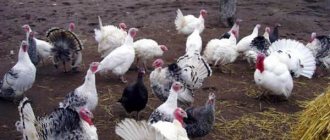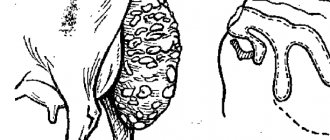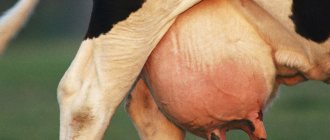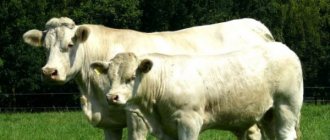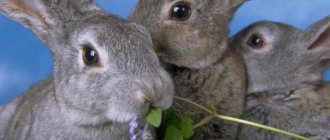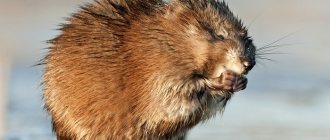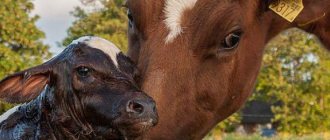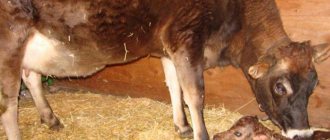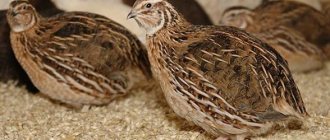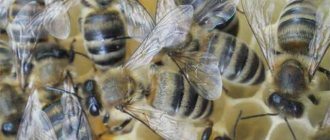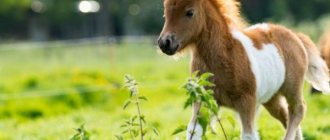Keeping a goat
Typically, adult males are given a separate enclosure.
It is not recommended to keep animals all together, as their strong aroma will be transferred to the milk. Before building a shed, choose a suitable location. It should be located high, in a dry area. The façade and courtyard for walking must be on the south side. The walls of the building are made of clay, concrete, boards or logs. They should be carefully caulked so that there are no holes.
The yard for walking must be fenced with a fence 150 cm high. It is forbidden to make the floor concrete. It is built from clay, boards, on which hay (for comfortable living) or earth is poured. In addition, it is necessary to make a slope to collect slurry, which is removed regularly. Thanks to the drain, the unpleasant odor will not be as persistent and the air will be dry.
The storage room must meet the following requirements:
- normal ventilation;
- keep the barn clean and dry;
- correct lighting, because this affects the amount of milk yield;
- as soon as the goat becomes pregnant, the goat is moved to a separate pen;
- in winter the temperature in the barn should be at least 10 degrees;
- In summer, the room is ventilated every day, since overheating is no less dangerous.
How do you know if a goat is pregnant?
Due to the fact that it is sometimes difficult to determine the real pregnancy of a goat, especially for a novice farmer, you can resort to additional methods.
Analyzes
When symptoms of pregnancy appear, the breeder conducts the following tests to determine the female’s gestation:
- Determination of progesterone levels (in urine, blood and milk). A hormone that, 3 weeks after mating: increases in the case of pregnancy, and decreases in the absence of pregnancy. You can determine it using test strips purchased at a pet store or when donating blood.
- Palpation. This method should be used in the third month of pregnancy, after first protecting the goat from food for 12 hours.
- Ultrasound. The most reliable method that all farmers should use. Its advantage is that it reliably reflects the process of pregnancy and possible problems.
Traditional methods
- Take 100 ml of morning goat urine (about half a glass), then add 1 tsp. baking soda. If the liquid hisses, the female is not pregnant, and if no hissing is observed, and soda accumulates in the sediment, the goat is a cat.
- After 1-2 weeks, take a little milk and add it to a glass of water. If the milk is evenly mixed, the goat is not pregnant. And if it settles to the bottom of the glass, then it’s sukoznaya.
First half of pregnancy
Diets for goats in the first half of pregnancy can be divided into 2 groups:
- for dairy animals;
- for dry wood.
Preparing goats for the breeding campaign with traditional rearing comes down to weaning the young animals and gradually stopping milking. Therefore, by the mating period, goats are in dry wood. This method is practiced when breeding meat, wool, and downy goats; it can less often be observed in dairy goat breeding - on personal farmsteads.
During the first 2-2.5 months of pregnancy, no noticeable changes occur in the body of goats, so there is no need to seriously change the diet, increasing its nutritional value. The first half of gestation of meat-and-wool breeds of goats occurs at the end of the grazing season and the beginning of the stall season - mating is carried out in September - October, so at this time a feeding change is carried out:
- hay is provided at the dacha in the morning;
- during the daytime the goats graze in the pastures;
- evening feeding - hay, straw cutting.
Since the nutritional value of grasses is low at this time of year, fertilizing can be done. But if the animals are well fed, this is not necessary.
In dairy goat breeding, milking is not stopped during insemination. Goats continue to produce milk for another 2-3 months after mating, and the start is carried out in the second half of pregnancy. Although the fetus at an early stage of development does not consume much energy and nutrients, they are required for milk production.
The body of purebred dairy goats can work for wear and tear - the lack of nutrients necessary for lactation and fetal growth will be compensated by the animal's reserves, which leads to exhaustion, abortion, postpartum complications, problems with the skeleton and internal organs.
Diet for a pregnant goat in winter with a milk yield of up to 2 kg per day:
- cereal or meadow hay – 0.4 kg;
- legume hay – 0.4 kg;
- barley straw – 0.3 kg;
- corn silage – 2 kg;
- barley or oat grain – 0.2 kg;
- Sunflower meal – 0.2 kg;
- vitamin-mineral premix.
Feeding a goat before lambing should be adjusted depending on the body condition and the amount of milk received. It is also recommended to gradually reduce the energy level of the feed, its protein and carbohydrate content. This is done to prepare the goat for launch.
Diets in the second half of pregnancy
Proper feeding of goats before lambing in the second half of pregnancy should solve several problems:
- provide nutrition to the fetus, which dramatically increases growth rates;
- prevent obesity and the development of postpartum complications;
- prepare the goat for lactation;
- have a small volume.
Pregnant goats should not be fed straw - this product has low nutritional value, so the goat needs a large amount of it. And the volume of feed consumed by a pregnant goat is limited by the size of the rumen, which at this time is compressed by the enlarged uterus. Also, the goat should not be fed silage (especially sour) or large amounts of concentrates, as these products lead to pathologies of digestion and metabolism.
Straw and stale hay should not be given to goats during pregnancy.
It is strictly forbidden to use spoiled root vegetables (with rot, mold, dirt), grain affected by pests, stale and rotted hay as feed. Only high-quality feed can be included in the diet of pregnant animals. Root vegetables and other succulent foods should be given sparingly - a large amount of water in the diet, combined with physical inactivity, leads to swelling of the limbs.
Goat diet a month before lambing at home:
- mixed hay – 2 kg;
- compound feed – 0.3 kg;
- root vegetables – 0.5 kg;
- brooms – 0.3 kg.
A week before giving birth, the feeding of goats with good fatness needs to be changed again - it is necessary to reduce the energy and protein content in the diet, so the feed of concentrates is reduced. A day before kidding, the queen may refuse to feed - this is a normal reaction during lambing.
Hay and brooms
How to properly start a goat before lambing in winter is, of course, a very important question for any farmer
But it is equally important to decide what to feed the animal during this period. Of course, the goat should be given exclusively high-quality food before giving birth.
The following types of hay are considered suitable for such MFA:
- meadow;
- steppe;
- forest
The best type of hay for pregnant goats is forb or cereal-legume hay. Of course, this food should not be too wet, moldy or dry. You need to give goats green hay with leaves.
Also, such animals are given straw and corn stalks. It will be very useful to prepare maple, birch, oak, and rowan foliage for the goat for the winter. In addition, for this MRS, zucchini vines, potato and beet tops are often dried. All this food for a pregnant goat before the launch will be very useful.
Also, the animal must be given dried brooms from branches:
- willows and willows;
- ate;
- alders;
- elm and elm, etc.
You can offer branches from almost any tree to pregnant goats. The only exceptions are poisonous ones. Also, experienced farmers do not recommend giving goats too many birch brooms. Such food can cause kidney disease in the animal.
Rules for milking a goat after lambing
Milking after childbirth should be done regularly. Nature dictates that kids drink the milk completely at first, but the goat needs to be milked additionally, even if she continues to feed her offspring. This makes the future milking procedure easier and also allows you to free the udder from milk residues.
From the moment of birth, the kids are placed separately so that with their horns they do not injure the mother’s irritated udder and do not learn to constantly be near her.
Manual technique
Before hand milking, the goat is restrained, although this is not required if it is already accustomed to its owner and behaves calmly. It is believed that a familiar voice acts as a calming factor for the animal, guaranteeing safety, which is why it stops resisting or kicking. Therefore, when milking, it will not be a bad idea to chat with the goat.
How to do manual milking:
- After birth, the first few streams of colostrum are poured into a separate cup due to the danger of containing pathogenic microorganisms and dirt.
- It is not recommended to deposit it on the ground or floor, otherwise, even with regular cleaning, a specific aroma will appear over time.
- The milking process should not be interrupted, nor should the pace be changed. You need to do it quickly, at the same speed, rhythmically. This will be more convenient for the farmer and more comfortable for the animal.
- Usually the first few days milk is given to kids, even if they are weaned from their mother.
Upon completion of the process, it is necessary to wipe the mammary glands from the remaining milk, also massage a little with your hands, preferably lubricate with a special cream, for example, baby cream.
Important! The milk from the udder must be milked completely, to the last drop. The last portions of milk are the most saturated in terms of fat concentration.
Unmilked remains can cause inflammation and disease.
Using a milking machine
Milking an animal with a milking machine greatly simplifies the process for the farmer, especially when there are more than 10 heads, but it is advisable to pay more attention to the comfort of the goat:
- during milking with the machine she needs to be fed;
- It is recommended to secure the animal’s legs in advance using special stands, but you can get by with a simple rope;
- disinfection of the apparatus, washing with massage of the udder are necessary;
- The first streams are usually also separated by hand into a separate cup.
After securing the device, it is recommended to monitor the uniform flow of milk into the container. When the milk stops flowing, you can remove the device. It is recommended to milk the leftovers by hand. Afterwards, the udder is wiped, smeared with cream, the milking machine is washed, and the goat is sent to the herd.
Features of care
Throughout the pregnancy of a goat, it requires special care, which will ensure the successful bearing of offspring and the health of the mother.
For a pregnant goat
In order for a pregnant goat to have the opportunity to give birth normally, it is necessary to adhere to certain rules of care.
- 35-40 days before the probable lambing date, stop milking the animal. This period can be made less painful by gradually eliminating lunch milking, followed by the rest.
- Reduce the consumption of succulent and green feed, remove all concentrates from the diet, leaving only high-quality meadow hay.
- Reduce the duration of grazing to 4 hours a day.
- Offer root vegetables to the female only in boiled form.
- 4-5 days before lambing, feed the expectant mother only wheat seedings.
- Ultimately, the nutritional value of the daily menu should decrease by 2 times.
- For the last 2 months before lambing, protect the goat from drafts, sudden changes in temperature and high humidity.
- Try to lay out more straws for the woman in labor, since she will be lying down most of the time.
Post-lambing care
Immediately after the baby goats are born, their mother requires special attention. Give her a drink of sweetened water, and after 1.5 hours feed her some good hay. For the next 3-4 days, feed 3-4 times a day, offering hay and easily digestible concentrates. Only after a week introduce succulent types of food.
The first contaminated milk streams are milked after the placenta has passed, after which the colostrum is sucked out by the newborn kids. If the milking process is performed manually, then the first week milking should be done every 3-4 hours, and the second week - four times a day.
In order for the farm to always have milk and regularly experience livestock growth, the breeder needs to cover the goat on time, determine pregnancy and provide the female with proper care. The time before lambing of the goat should be made as comfortable as possible for the animal, increasing nutrition and protecting it from stress. In addition, the assistance described above to the mother during childbirth will eliminate the risks of pathologies and ensure the appearance of healthy offspring.
What are the signs to tell if an animal has gone on a spree?
Before the first mating, a sexually mature female must gain sufficient weight (slightly more than 30 kg). This indicates that the animal is fully mature and ready to bear offspring. Goats weigh this much at 7–9 months.
You can tell that an animal is walking by signs such as:
- Redness and slight swelling of the external genitalia.
- Previously peaceful females may become irritable and aggressive, and begin to restlessly explore the area.
- Animals constantly sniff, trying to catch the scent of a male, and wag their tails.
- In some cases, the goat loses its appetite.
- Discharge from the genitals.
Important! In some females, heat occurs with virtually no signs. If you suspect the onset of estrus, you need to pat the goat on the back
If the time has come, she will start wagging her tail.
The goat felt bad
There are often cases when, during or after childbirth, the female’s condition sharply deteriorates: weakness appears, the pulse quickens or decreases, etc. If measures are not taken, the animal’s life will be in jeopardy.
During childbirth
Deterioration in the goat's health during childbirth is a common manifestation. The animal may experience fatigue as the birth process drags on. Offer her some sweet water or coffee.
Prenatal paresis is manifested by the following factors, which appear in increasing order:
- Change in gait, even dragging feet.
- Decreased activity due to inability to raise the butt and stand on the hind legs.
- The goat begins to move on its knees, and the problem of supporting itself on its front legs arises.
- Trembling appears, but appetite remains good.
- Deterioration of appetite, refusal to eat.
- A comatose state appears: the animal lies with its neck extended in an S-shape, its eyes are closed, and its limbs are cold.
First aid to an animal before the arrival of a veterinarian consists of the following measures:
- Don't milk the goat.
- Give an intramuscular injection of calcium gluconate 10 ml into each leg.
- Intramuscular injection of 2 ml "Tetravita".
- Massage the goat's back and legs using any warming product.
- Cover the animal to keep it warm.
After childbirth
During this period, the immune system cannot 100% protect a weak body and inflammation of the udder or uterus and vagina very often occurs. They must be treated in time to prevent them from becoming chronic. The milk productivity of the goat and its ability to bear offspring in the future depend on this.
The most dangerous disease, leading to gradual paralysis of the entire body, is postpartum paresis. If you do not take measures to treat it, the same as for prenatal paresis, the goat will die.
Goat pregnancy
Pregnancy (graviditas) is the physiological state of a goat during the fruiting period. Pregnancy in a goat begins from the moment of fertilization and ends with the birth of mature kids. In practice, experts consider the day of the last (fertile) insemination to be the beginning of pregnancy.
Pregnancy in a goat is usually multiple. According to their course, experts distinguish:
- Pregnancy is physiological, characterized by the normal state of the body of kids and goats.
- Pregnancy is pathological when it is accompanied by disruption of physiological processes in the goat’s body and developing fetuses.
Read also: How to make a stall for a cow
What is included in the diet of pregnant goats?
Pregnancy in goats lasts five months. Three weeks after successful mating, milk yields in dairy breeds decrease. They are sent to launch 1.5-2 months before lambing. During an interesting period, the animal needs careful care. Cold water, poor quality, moldy, spoiled food can cause miscarriage. The expectant mother should not be overfed; excess weight will complicate childbirth. Two to three weeks before lambing, a fat goat is “put on a diet”, the amount of feed is reduced, and instead of succulent feed, warm swill with bran and boiled root vegetables is given. Good maintenance guarantees a successful resolution of the burden.
The animals' diet includes corn, oats, and barley. The grain must be dry, of good quality, without musty odor, crushed. The diet contains potato peels, beets, carrots, pumpkin, and Jerusalem artichoke. They are fed raw - this is a source of vitamins, they should be finely chopped. The mash is prepared - the grain is steamed with kitchen waste: dry bread crumbs, vegetable peelings. During the dry period, mash is removed from the diet because it promotes milk production.
What diet should be provided to pregnant goats?
Feeding animals is a very important moment in the life of any farm, and providing pregnant animals with the right diet is even more important. Stale, low-quality food combined with cold water have a negative effect on the fetus and can cause miscarriage or untimely lambing.
In the summer, goats should receive the following types of feed in the required quantities:
- green mass;
- feed;
- grain mixtures.
One animal must be allocated at least 0.8 kg of feed and 0.7 kg of grain per day. You can additionally diversify your diet with root vegetables, but beets should be excluded (in some cases they can cause miscarriage).
In winter, the green mass is replaced with hay or straw. As additional nutrition, branch food is prepared by cutting off green branches and then drying them. Animals also eat very well coniferous branches, which contain large quantities of vitamins and essential oils, which are valuable sources of nutrients for the body of a pregnant goat.
In the second month, it is imperative to include mineral supplements in the diet in the form of the following ingredients:
- feed chalk;
- bone flour;
- crushed egg shells.
Such components will be necessary because At this moment, the active formation of skeletal bones in the fetus is underway, and therefore the need for calcium increases. Veterinary pharmacies offer an analogue to all these components in the form of mineral and vitamin supplements, which contain calcium in large quantities.
In the fourth month, goats gradually begin to remove feed and grain from their diet so that the fetus does not reach too large a size. Otherwise, the birth process may occur with serious difficulties. 21 days before the expected lambing, the feed should be completely removed.
If the goat gains excessive weight, 30 days before giving birth, reduce the feeding rate and remove all food that contains a large amount of calories.
You should know that during this period the goat must be protected from dampness and drafts. When grazing on pasture, you should avoid steep slopes and hills. It is necessary to give preference to flat terrain. If the animal jumps a lot, then such active movements can cause miscarriage.
How long does pregnancy last and when to start after coverage?
In an animal, pregnancy lasts 5 months, and in the second half, an increasing amount of nutrients is required for the harmonious and proper development of the fetus. To avoid problems with the health of the offspring and the mother, we recommend starting a goat at 3–3.5 months of pregnancy.
In order to correctly determine when to start an animal, monitor the amount of milk produced. When the daily milk volume drops to 1 liter, feel free to start the goat. The duration of this process depends on the individual characteristics of the animal, their potential productivity in milk production and what the goat eats.
Breeds with low milk yield start much faster. The same applies to a goat if it is on a monotonous diet, while animals that produce a large amount of milk and receive varied and nutritious nutrition may not experience problems with lactation until lambing.
Pay attention to the characteristics of each animal in order to correctly determine the time of launch and decide whether to launch the animal in principle. In order to promptly initiate the procedure for starting a goat, it is necessary to know whether it is a cat or not.
Kittenness, in other words, is pregnancy. In the current conditions, you can entrust this to specialists from veterinary clinics who will conduct blood tests, check cervical fluid and perform an ultrasound examination. All these methods are very accurate and allow you to accurately determine the position of the goat
In order to promptly initiate the procedure for starting a goat, it is necessary to know whether it is a cat or not. Kittenness, in other words, is pregnancy. In the current conditions, you can entrust this to specialists from veterinary clinics who will conduct blood tests, check cervical fluid and perform an ultrasound examination. All these methods are very accurate and allow you to accurately determine the position of the goat.
But there are simpler and more familiar ways for many farmers to determine the quality of an animal:
- Lack of heat in a female individual - to determine potential pregnancy, bring the female to the male after 18–20 days. If she does not show any desire to mate, most likely she is a male goat. If we talk about reliability, then this method cannot be called one hundred percent, but it is quite informative and has confirmed its effectiveness more than once.
- External changes that affect the genitals: mammary glands enlarge, under the tail you can notice a smoothing of the skin and folds. As the period increases, the belly grows, which is especially observed along the protruding sides.
- Changes in behavioral reactions - the goat becomes more attentive, listens to the movement of the fetus and licks its belly. When people try to touch a pregnant animal, it may express dissatisfaction.
- Rectal method - it involves inserting a human finger into the rectum of an animal. With its help, you can determine pregnancy by the severity of the uterine artery. If it is easily palpable and is characterized by excessive tension, this is a clear sign of pregnancy.
- Palpation – from approximately the third month of pregnancy, the presence of a fetus can be felt with your hands. We recommend this procedure be carried out in the morning before the first feeding. Calm the animal and gently place your hand on the right side of the abdomen. If you feel slight tremors, this is a sure sign of pregnancy.
All of these methods are suitable for more experienced farmers who are familiar with the animal's physiology and behavioral instincts.
There is an opinion that in the summer, when the goat receives a sufficient quantity and quality of feed, there is no need to start it, so as not to deplete the animal’s body by limiting the diet in valuable summer feed.
First week after lambing
Sheep and goats, like all farmyard animals, treat their offspring with care and tenderness.
Mothers’ voices even change and become softer. By the end of the first week of life, the lambs are already strong and constantly suckle from their mother. After three weeks, the lambs with their uterus can be released into the herd: they are already frisky, playful, and need space to jump and run. As for goats, care here is more difficult - after all, in addition to offspring, goats are expected to produce milk. During the first days you need to milk 4 times a day, or even more often. Then switch to triple milking. It all depends on the condition of the udder: the more swollen it is, the more often you need to milk, while doing a gentle massage from bottom to top. After 3-4 days, you can slowly introduce vegetables, grains or mixed feed into the diet, adding 30 g per day, gradually bringing it up to the normal norm of a dairy goat. The colostrum period lasts about 5 days, the first colostrum has a yellowish color and thick consistency, every day it becomes more and more similar to regular milk.
Goats should be fed 4–5 times a day, about 3 hours later, with warm milk at 38–40 degrees. If the baby refuses milk, most likely it has already cooled down. The amount of milk drunk is regulated by the kid himself. As a rule, he does not drink more than he needs. It is necessary to give a little and often, the whole secret is this, so that there is no diarrhea. After a week you can feed 3 times a day.
From the age of two days, bundles of fine, fine hay are hung in the pen with the kids. The kids begin to taste it early, this contributes to the development of the rumen.
How to determine the catness of a goat
For a timely launch, you need to know for sure whether the goat is a cat or not. These animals come to hunt seasonally - every spring and autumn. True, in some breeds the hunt stretches from July to January and from February to the end of May. Mating with a goat is not always successful, so to determine the female’s fertility (pregnancy), you need to carefully observe the animal.
You can determine the catness of a goat by special signs
In large industrial farms, pregnancy is determined by specialists in veterinary laboratories using blood tests, cervical mucus and ultrasound. For private owners, such research is not justified financially, and in most cases it is simply inaccessible.
There are several simple ways to determine cutness:
lack of hunting in females - if possible, 18-20 days after mating, the goat is again brought together with the male. If the female does not show any desire to mate again, most likely she is already a kitten. The method is not 100% accurate, but it is quite accurate and the only one available to goat breeders for determining the quality of milk in the early stages;
external changes - if after mating you carefully observe the animal every day, by about eight weeks you can see characteristic signs in the genitals. The skin under the tail smooths out, folds disappear, and a slight swelling is observed in the perineal area, which gradually becomes larger. In first-calf cows, from the 4th week, the udder becomes fuller and the milk veins on the abdomen swell. In the third month, signs of gestation are already obvious - the goat’s belly is noticeably enlarged, protrudes at the sides and sag slightly;
behavior changes - from the age of four weeks the female goat begins to frequently stretch like a cat, freezes and listens to the movement of the fetus, licks its belly. Many females do not allow their bellies to be stroked and behave more warily in the presence of their owners;
palpation - from the third month the presence of the fetus can be felt with your fingers. This should be done in the morning, before feeding, on the right side of the abdomen.
You need to probe carefully, do not press under any circumstances, sometimes it is enough just to put your palm on your stomach to feel light tremors. If the goat tenses its muscles and does not allow you to feel its stomach, you need to put one hand on its withers (the area above the shoulder blades, the line where the neck goes to the back) and lightly squeeze the skin in a fist
The animal likes this and makes him relax;
rectal method - you need to insert a finger into the rectum the entire length and feel the uterine artery in the upper part. If it is easily identified, and tension and noticeable vibration are clearly felt in its walls, this indicates pregnancy. True, this method is effective only from the third month, when external signs are already expressed.
There are other ways to determine catness, folk ones, with testing urine and milk by various means, but their effectiveness is very doubtful. If you are keeping a goat for the first time and cannot determine for sure whether she is pregnant or not, it is best to contact a livestock specialist or veterinarian. To correctly determine the timing of pregnancy, be sure to remember the date of mating.
Determining the catness of a goat: methods
what to feed a goat in winter: feeding goats in winter
In winter, livestock breeders are deprived of the opportunity to feed green feed to goats. However, even at this time of year, pets need nutritious diets containing vitamins. What to feed a Saanen goat or another breed of goat in winter? This will be discussed in the article.
What to feed a goat in winter: what to include in the diet?
With the onset of cold weather, feed distribution should be 3-4 times a day. Before giving new food, you need to clean out the remnants of the previous food from the feeders. In addition, animals need water. Buckets of water are placed during food distribution, or the room can be equipped with automatic drinkers, which reduces the cost of human labor.
When drinking by hand, it is important to take into account the temperature of the water; it should be at room temperature. The main diet in winter must include:
The main diet in winter must include:
- hay - distributed in the morning;
- vegetables;
- concentrated feed;
- roughage.
Vegetables, concentrated and roughage are distributed in the afternoon, observing the time interval. Don't feed everything at once.
It is recommended that animals have separate feeders with chalk and licks (salt).
Vegetables are given either fresh or boiled. They must be cleared of soil and rot (if any). Feeding green potatoes is not allowed.
It is preferable to cut fresh vegetables into small pieces or use an industrial electric grater on the farm, which is much more profitable when there are a large number of animals.
Boiled beets are not left in water after boiling; they must be drained.
An important aspect of the diet is the distribution of branch food. Animals are very partial to it, and the branches contain a large amount of useful substances.
When harvesting, preference should be given to birch, linden, aspen or willow. This process begins in mid-June.
The branches are cut off with young shoots, and then hung in a cool place (an attic or shed is suitable) where they remain for two weeks.
What to feed a pregnant goat in winter?
The proper development of the kids in the womb depends on the feeding habits of a pregnant goat in winter.
During this period, it is important to be careful about the quantity and quality of feed consumed by the animal. It is important that it is fresh, since putrefactive food can cause miscarriage
What to feed a pregnant goat in winter? The animal should receive the same beneficial elements as before pregnancy, but more vitamins should be included in the diet. Thus, it is necessary to give preference to green feed.
What to feed a goat before lambing in winter? A month before lambing, it is recommended to reduce the amount of feed that can cause fermentation. Fresh cabbage and rutabaga are excluded from the diet. In addition, a month before lambing, you need to take a break from milking, which is called starting the goat.
Feeding routine
When distributing feed, it is recommended to create a routine and stick to it. If three feedings a day are chosen, then equal intervals are set between distributions and feed is given by the hour.
Feeding begins with swill, then the distribution of succulent feed, and lastly - roughage. In the late evening, distribution of roughage is required; at this time, more tasty hay can be put aside. If the goats do not receive swill, then clean, non-cold water is given several times a day. Give the animals plenty to drink.
The swill includes: crushed grain, vegetable peelings, ground oatmeal, filled with water from cooking vegetables and with a small addition of salt. It should be noted that this food is not for everyone, and many animals refuse it.
Sample feeding schedule:
- morning feeding from 7 to 8;
- midday from 12 to 13;
- daytime from 16 to 17;
- distributing hay before bed.
At the end of the stall period, animals cannot be immediately transferred to pasture feed. With the onset of spring, while the grass is in a limited amount, the goats can begin to graze, and in the evening hours they can be fed grain and distributed hay.
Separately, it is worth noting that many breeders conduct a breeding period at the end of autumn so that lambing occurs in the spring months and the kids are stronger for the grazing period. Feeding barn and pregnant animals (in the first half of pregnancy) are no different from each other.
In the second half of pregnancy, before lambing, the queens are given better quality feed and a little extra concentrate.
What to feed a goat in the first half of pregnancy
Suspension is divided into two periods:
- first – 3 months from mating and intended insemination;
- the second – 60 days before lambing.
The first period is characterized by hormonal changes in the goat’s body and differentiation of tissues and organs of the offspring. The diet at this time should not change much compared to usual.
It is important to consider whether the goat is still milking or not. Dairy goats need more feed to support milk production.
Expert opinion
Zarechny Maxim Valerievich
Agronomist with 12 years of experience. Our best country expert.
Ask a Question
A gradual cessation of milking and preparation for a new period of milking in dairy goats, the so-called start-up, is recommended to be carried out in the second period of gestation.
In late summer and early autumn, the diet of pregnant goats consists of the following components:
- green mass - eaten by animals on pasture or grass cutting of legumes, cereal grasses;
- compound feed – 800 grams per day;
- grain mixtures (dry and steamed);
- branch food
The last type of food - branches - needs to be prepared for the goats in large quantities. Dry thin branches of birch, alder, aspen with green leaves in a straightened state or hanging them in a barn. Juniper branches can be harvested at any time of the year - it contains essential oils that are beneficial for animals.
See also
How to properly inject a goat with your own hands and the drug administration scheduleRead
» width=”750″ height=”400″ data-srcset=”https://dachamechty.ru/wp-content/uploads/2020/06/page-89.jpg 750w, https://dachamechty.ru/wp -content/uploads/2020/06/page-89-300×160.jpg 300w" data-sizes="(max-width: 750px) 100vw, 750px">
With the onset of winter, the green mass is replaced with hay and silage, and root vegetables are introduced into the diet, with the exception of beets, since it increases milk production and can cause miscarriage. Approximate diet for a mature dairy goat with a milk yield of 2 liters of milk per day:
- cereal grass hay (meadow) – 400 grams;
- legume grass hay – 400 grams;
- barley straw – 300 grams;
- corn silage – 2 kilograms;
- grain (barley, oats) – 200 grams;
- sunflower meal – 200 grams;
- vitamin and mineral supplement (premix).
For proper development of bone tissue in goat kids in the womb, vitamin and mineral supplements should be included in the diet. They can be purchased ready-made or prepared as a mixture of feed chalk, bone meal, and crushed eggshells.
